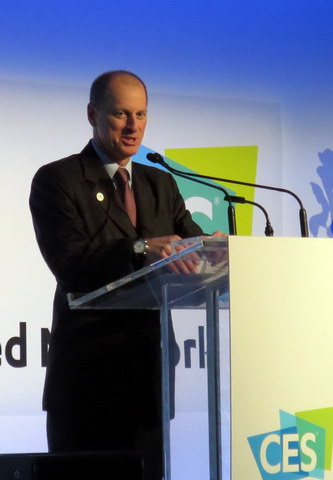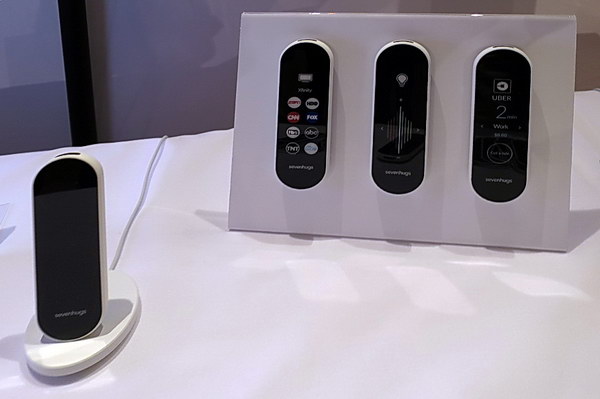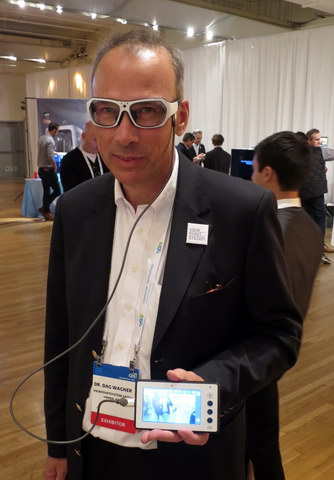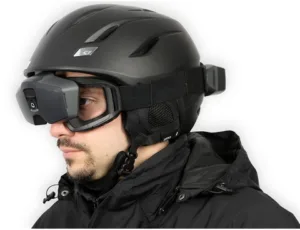CES Unveiled was held in New York on November 10th. It is mainly a press event, intended to get press coverage of the upcoming CES 2017 and present Consumer Technology Association (CTA) forecasts for the Christmas selling season. In addition, there are a number of tabletop exhibits, most of them for products that have received CES Innovation awards.
One of the most interesting things from the press conference was a discussion of voice interfaces rather than the graphical user interfaces (GUIs) that have dominated consumer digital systems since the introduction of the original Macintosh computer. According to the CTA, the first experimental voice interfaces in 1995 had a Word Error Rate (WER) of 100%. In other words, they couldn’t understand a single word you said. By 2013, the WER had dropped to 23% and the CTA expects the WER to drop to parity with human listeners by 2017.
Voice interfaces are important to the display industry precisely because they don’t require displays. Many current consumer products, such as home robots or wearables, don’t include displays and are purely designed for voice command for routine use, although most of them have a Wi-Fi or other interface for set up, BYOD (Bring your own display). The IoT space is another category of new technology that, to a large extent, has bypassed the display industry. While the use of displays will certainly grow in the future, the growth is unlikely to keep up with the growth of consumer technology overall.
 Gary Shapiro speaking at CES Unveiled in New York on November 10th (Photo: M. Brennesholtz)
Gary Shapiro speaking at CES Unveiled in New York on November 10th (Photo: M. Brennesholtz)
The CES 2017 show will be its 50th year. Gary Shapiro, President and CEO of the CTA, congratulated Panasonic because it has been an exhibitor at the show every year since the beginning, back when it was still called the Consumer Electronics Show. He said there were nine other companies; 3M, Memorex, Lenovo, Philips, Sharp, Sony, Toshiba, Voxx (known as Audiovox in 1967) and Westinghouse; who exhibited in 1967 are still exhibiting in 2017, although they did not exhibit in every show in-between.
Shapiro also made rather neutral comments on the election of Donald Trump as president. Trump’s positions on immigration and free trade are diametrically opposed to the CTA’s positions on these issues. Trump also favors the mid-west rust belt over the east and west coasts. In addition, Trump is not very technology savvy and favors smokestack industries like coal, steel oil and automobile manufacturing over the technology industries that are represented by the CTA. While Shapiro did not suggest this directly, I suspect there is likely to be some friction between President Trump and the CTA in the coming years.
Some products at the CES Unveiled table top exhibits that included innovative use of displays included:
A skier wearing eMagin’s BlazeTorch for night skiing. (Photo: eMagin)
eMagin Corporation has always been a supplier of OLED microdisplays for HMDs for the military and other applications that can support the high price of the company’s microdisplays. At CES Unveiled, they showed their first foray into consumer products, two night vision systems called the BlazeTorch and BlazeSpark. The BlazeTorch is night vision HMD based on a very low light camera (0.001 Lux) and a pair of eMagin SXGA (1280 x 1024) microdisplays. The 720p camera actually has a wider wavelength range than the human eye and covers from deep blue at 0.4µm through near-IR at 1.2µm. For use when there is no ambient light at all, there is an IR illuminator built into the camera module. The BlazeSpark uses the same low light camera and IR illuminator but uses a BYOD display – currently an Android smartphone. Dan Cui, Chief Marketing Officer, HMD division, told me there is an iOS version of the Spark in the works that is waiting on approval by Apple before it can be put on the market.
The BlazeTorch uses a pair of monochrome eMagin SXGA microdisplays, both showing the same image, i.e. the system is not 3D. The camera and microdisplay module flip up to allow the user to see the outside world directly when desired. It will operate for up to 3 hours on an internal Li-ion battery. Latency between the camera and the microdisplays is very low – about 0.5mS according to Cui – allowing it to be used for response-time critical applications such as skiing or mountain biking. He said one consumer application of the BlazeTorch will be among boaters.
Docking is never easy and docking at night is more difficult because, well, it’s night. By making the dock, other boats, buoys and the shoreline visible and leaving the boaters hands free for other tasks like steering the boat, BlazeTorch will greatly simplify this task. The BlazeSpark is designed for hand-held use and latency between the outside world and an Android smartphone is about 30mS. Both the Spark ($299) and the Torch ($999) are available for pre-order now. BlazeSpark for Android with either a micro USB connector (Samsung, Note 5, S6 , S6 Edge, S6 Plus, S6 Edge Plus, S7 , S7 Edge; LG V10 supported) or USB type C connector (LG V20, G5; HTC 10; Huawei P9 and P9 plus supported) is expected to ship on December 5th and BlazeTorch on December 30th.
 Sevenhugs smart remote. L. on its charging station, R. three simulated images of the device controlling different devices. (Photo: M. Brennesholtz)
Sevenhugs smart remote. L. on its charging station, R. three simulated images of the device controlling different devices. (Photo: M. Brennesholtz)
Sevenhugs Inc. was showing a mockup of a smart remote control said to be able to control any device, including those with IR, Bluetooth and Wi-Fi interfaces. The device will have a touch-screen LCD display that covers its entire front surface. The demonstration unit they were showing at CES Unveiled only had a small portion of the device covered by a small LCD display.
 The Sevenhugs smart remote can control almost everything in a smart home. If it really can control the weather, I’ll buy one myself. (Image: Sevenhugs)
The Sevenhugs smart remote can control almost everything in a smart home. If it really can control the weather, I’ll buy one myself. (Image: Sevenhugs)
In a modern media room, there can be many devices controlled by a remote control. When you point the Sevenhugs smart remote at a device to be controlled, it can tell which device you are pointing at based on the interaction of the smart remote with three sensors spaced around the room. If there are several devices so close together the system cannot tell which you are pointing at, for example, a TV, a surround sound processor and a cable box, the smart remote will show a graphical menu allowing you to select the desired system. The need for these sensors means the Sevenhugs smart remote can only be used in a single room.
The representative of Sevenhugs at CES Unveiled said the company is working on multi-room capability but the first generation will only work in a single room. He added that the business model is a purchase model, not a subscription. When new home IoT systems needing control are introduced (Daily!), Sevenhugs will develop the necessary drivers and allow owners to download them for free. The Sevenhugs smart remote is available for pre-order on Kickstarter for $179, with expected delivery in July, 2017. MSRP for the unit when it comes on the normal market is expected to be $299.
 Dr. Dag Wagner, CTO of Viewpointsystem, wearing a set of the company’s glasses and showing the image produced on the control box in his hand. (Photo: M. Brennesholtz)
Dr. Dag Wagner, CTO of Viewpointsystem, wearing a set of the company’s glasses and showing the image produced on the control box in his hand. (Photo: M. Brennesholtz)
Viewpointsystem was showing their VPS-16 eye-tracking smart glasses. These glasses include three cameras looking back at each of the wearer’s eyes to track pupil position and a camera looking forward. The image produced by the forward-looking camera includes where in the image the wearer is focusing his attention, based on pupil position. This composite image can be recorded for future analysis or streamed to a remote location. By analyzing pupil size as well as position, the VPS-16 can also give an indication of how the wearer feels about what he is seeing. The eye tracking ASICs are embedded in the frames but the recording and broadcast hardware are in the external control box.
Unlike augmented reality (AR) systems like Google Glass, there is no near-the-eye display to provide visual feedback to the wearer although Viewpointsystem says the VPS-16 can work with external AR systems. One application of the live streaming would be, for example, a maintenance application where a remote expert could see what the maintenance worker is seeing, including exactly what the worker is focusing on. The system is also said to be useful in applications such as driver training, where the instructor can tell if the trainee is focusing correctly on the road ahead, checking his rear view mirror, etc. or if he is focusing too much on something else, such as the speedometer or the sound system controls. At a price of $16,500, this is clearly not a consumer product and is intended for professional applications, at least for now. –Matthew Brennesholtz

